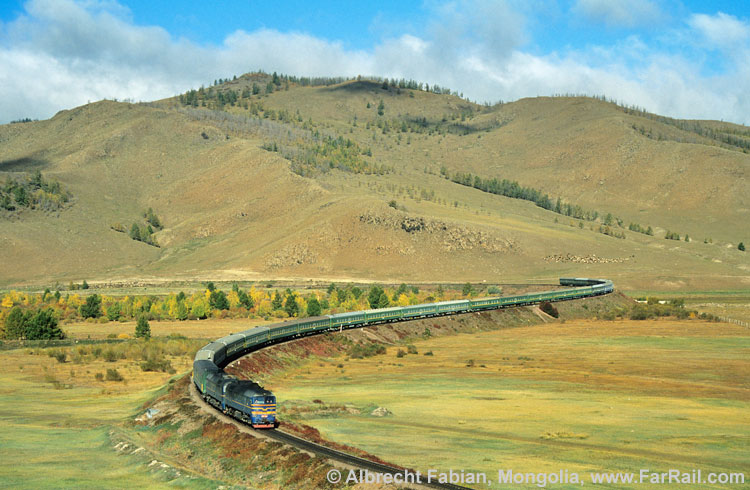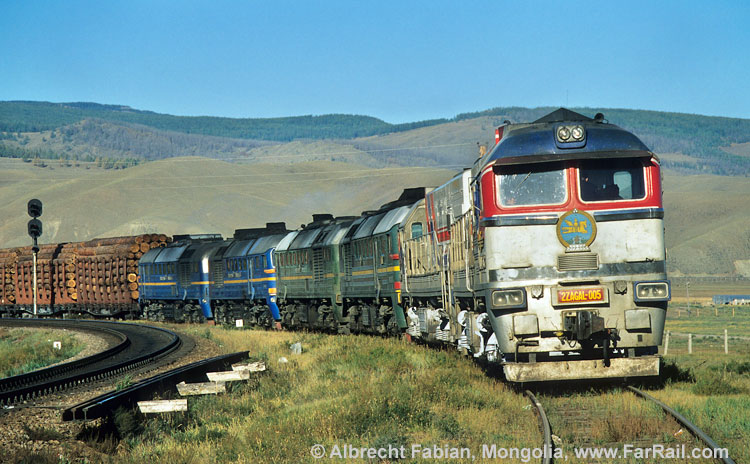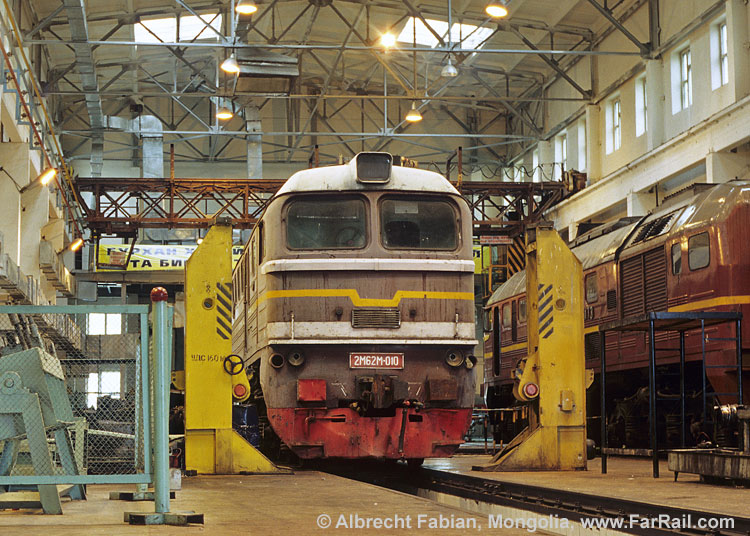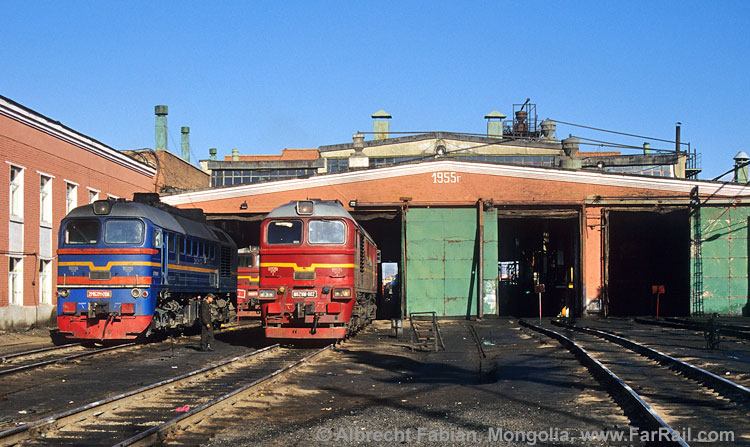

They do exist - pictures of the Mongolian railway. Trans-Siberian Express travellers take them on the way from Moscow to Beijing as a view from the train window or from the platform in Ulaan Baatar main station. Rarely, though, is Mongolia itself the main interest for railway enthusiasts and wrongfully so. The Mongolian Railways feature a number of interesting subjects and the Mongolian people and landscapes are fascinating in themselves. What else goes on in this supposedly secluded part of our world?
Our main interest is the diesel locomotives and it’s no secret. This Central Asian country has developed into the absolute “El Dorado” for enthusiasts of the “Taiga Drum”, the M62 class. There remain many originally delivered, acquired second hand or rebuilt locos in service. There is one irrefutable fact:
There is no country in the world outside Russia which has such a variety of members of the M62 family!

First a look at the double-section locos:
and now the single units:
Further varieties are possible, all M62UM are still awaiting rebuilding.
In contrast to M62-types in other countries all Mongolian locos have the high “Mongolian Smokestack”.

|
Date |
Itinerary |
|
14.09. |
Departure Berlin-Schoenefeld by SU114W dep. 14.15 hrs, arrive Moscow Sheremetievo 18.55, change to SU563W for Ulaanbaatar , departure 20.20 hrs |
|
15.09. |
Arrival Ulaanbaatar at 06.10 hrs. After a brunch we’ll take our bus for linesiding along the Trans-Mongolian Railway – we leave the capital westbound and will wait for trains around Emeelt village; hotel in Ulaanbaatar |
|
16.09. |
All day linesiding in the Bumbat Pass area (Northern section); the travellers can go their own ways – our bus stands nearby the Khonkhor station as catering base for hungry and thirsty photographers; hotel in Ulaanbaatar |
|
17.09. |
Today we need mini buses because we enter the world of the earth and gravel roads; nearby Züünkharaa we start with linesiding and follow the Trans-Mongolian Railway northbound via Bayangol (Baruunkharaa) to Darkhan, the largest town in Northern Mongolia; hotel in Darkhan |
|
18.09. |
Today’s subject is the branch line Darkhan 2-Sharyn Gol – there are not many trains and so we must start early in the morning. With a little luck both passenger trains in the daylight will take freight cars as mixed trains; the time in between we’ll use for a sightseeing trip in the Sharyn Gol area or – it depends on the weather – we’ll go for linesiding around the Darkhan 2 station; hotel in Darkhan |
|
19.09. |
After visiting the loco depot at Darkhan we’ll board the regional (may be mixed) train No. 701 to Süchbaatar, the border station with Russia. In the afternoon we take pictures of arriving and departing passenger and freight trains; after nine o’clock we’ll board our accommodation for the night – the sleeping car compartments of the train No. 264 to Ulaanbaatar |
|
20.09. |
After arriving in Ulaanbaatar ca. 06.30 we have a breakfast in a restaurant; for the morning we have enough time to visit the large Ulaanbaatar loco depot which is the one and only locomotive workshop as well. After this we’ll take lunch in a restaurant. Before boarding the night train to Zamyn Üüd (around 16.30) we’ll take pictures in Ulaanbaatar passenger station. Sleeping car compartments in the Ulaanbaatar – Zamyn Üüd overnight night train No. 276 |
|
21.09. |
Zamyn Üüd is the border station with the Chinese railways, trains change their gauge. This is the only place where standard gauge MTZ locomotives are located. We will take pictures in the station and in the small depot and go linesiding around Zamyn Üüd. By bus we go north-west bound to Erdene village and take a runpast; in the late afternoon we’ll go “off road” through the Gobi desert to a tourist camp near to Saynshand. We’ll spend the night in authentic Mongolian tent houses; accommodation in a tourist camp |
|
22.09. |
Today’s main item is taking pictures at the Saynshand station and loco depot. In the afternoon we’ll visit the Chamariin chiid, the Buddhist “Monastery of Noses” in the Gobi desert; accommodation in a tourist camp |
|
23.09. |
In the morning we go by bus around 200 km from Saynshand to Bor Öndör, mostly using the asphalt road following the Trans-Mongolian Railway. If we get a chance we’ll take pictures of a train; from Ayrag we follow the branch line to Bor Öndör where a big mining company exists – pictures in and around the Bor Öndör station. Ca. 21.00 we’ll board the night train 709/285 to Ulaanbaatar in sleeping cars. We’ll use this train as far as Khonkhor and arrive there the next morning: |
|
24.09. |
Ca. 08.00 we leave the train 285 in Khonkhor and go by bus to the Baganuur hard coal mining city; this coal mine is important for supplying Ulaanbaatar with energy. We’ll get a runpast at the newly built Ghingis Khan memorial. In Baganuur station we’ll see some TEM2/TE2U doing the transfers from MTZ to the mining company and we’ll try to take some pictures of full and empty coal trains. Lunch will be fully authentic in the railway worker’s restaurant. In the afternoon we come back to the Trans-Mongolian Railway and have linsiding at the South part of the Bumbat Pass. Back in the capital we’ll have a goodbye dinner, Hotel in Ulaanbaatar |
|
25.09. |
Transfer to the Ulaanbaatar airport, departure Ulaanbaatar by SU564T 07.35 Moskow-Sheremetievo 10.15, change for Berlin-Schoenefeld SU113T 12.25, arrive Berlin- Schoenefeld 13.15 – or an individual flight to your home town. |

Mongolia, a large and wide country with low settlement, has developed a special kind of tourist infrastructure. Hotels exist only in bigger cities but they are normally professionally managed. Not all hotels offer Western European standards (with toilets and washing facilities inside the rooms). Normal accommodation near to tourist highlights in the countryside is in tourist camps in which the customers stay in authentic Mongolian tent houses. An overnight stay in such conditions has its own charm but the sanitary facilities are simple and single rooms often impossible.
The sleeping cars in the regular trains have only four-bed-compartments.
Most Mongolians in the countryside are well known for their unreserved and hearty hospitality and don’t know words such as theft or robbery. However Ulaanbaatar, like every other big city, has its social problems and its own special criminality. Petty crime such as theft or pick pocketing is no worse than in European countries. Nevertheless, you would be well advised to keep a close eye on your photo equipment and your baggage.

Mongolia has an extremely continental climate with warm and wet summers and very bleak winters. At the time of our journey the rainy summer has already finished. The weather can change very quickly from summer heat to snowfall. Sometimes we’ll reach locations by climbing cattle fences or wading through small brooks. Please organise your clothing according to these requirements.
The road conditions in Mongolia cannot be compared to Europe. Only a small number of international roads are paved. Riding the gravel or earth roads with our mini buses feels like an “off-road-experience”. That’s why our journey is only suitable for people in a good state of health.
The time in Mongolia during our journey is eight hours ahead of Greenwich Mean Time and six hours ahead of Central European Summer Time.
Photographing railways is mainly unknown in Mongolia but doesn’t cause problems when taken from public places. Railway workers like the taking of pictures as it shows interest in their work. FarRail Tours found during the preparation this journey general goodwill from the MTZ, the Mongolian State Railway. However, it’s impossible to get a formal written permit for visiting loco depots. Traditionally the executive staff set great store by welcoming and guiding guests themselves. Not always, though, can the appointment book of the depot director be co-ordinated with our journey schedule. That’s why we can’t give a general guarantee for depot visits.
The journey is arranged on a full-board basis but please note that on a few occasions, depending on train movements and secluded locations, we may not have time or the opportunity for regular meal breaks. That’s why some meals, usually breakfast or lunch, may be given as packed boxes. During bus rides we’ll serve a cup of tea or coffee. It’s a good idea to bring your own cup with you.


Paying with credit cards in restaurants and shops is not widespread. Cashing traveller cheques is generally possible in a bank but it costs a lot of time which we don’t have on this trip. The best way to proceed is by changing notes (Euro, Pound Sterling, US-Dollar). Money exchanges exist in Ulaanbaatar and other cities.
Electricity (220V, 50 Hz) is available in all our hotels. Usually, but not always, the Mongolians use the normal European standard. To be sure, it’s better that you take a multiple-system adapter for the sockets. Because it is senseless to arrange a telephone cable network in the wide and deserted country the Mongolians operate a well organised mobile phone network. Mobile coverage is good in all areas where people are living. Please take care as you will have to pay roaming costs for incoming phone calls as well as outgoing.
Visa formalities have changed often in the past. Generally, entry to Mongolia requires a minimum 6 month valid passport with a complete free side for the visa. Together with a passport photo you must apply for a visa at the Mongolian Embassy in your own country. The application form can be sent by FarRail Tours if you ask. FarRail Tours will also supply a certified invitation or hotel reservation for an extra charge if it is necessary. In the past (and also at present) it’s possible to get a visa when arriving in Ulaanbaatar airport. However, the Russian airline Aeroflot can refuse the flight if you don’t have a visa for your destination country.
Travellers to Mongolia should have an acceptable health insurance. Please ask your insurance company if your police is valid in Mongolia.
We must warn you of the risks with railway traffic. A high visibility vest must an obligatory part of your luggage. Recommended for all people is an accident insurance because FarRail Tours and partners cannot accept liability for injuries.

| Mongolia | ||
| Taiga Drums in Mongolia | 12 to 28 participants | £2,240 |
| 14.09.2010 – 25.09.2010 | Single room surcharge | £195 |
| Registration Deadline: 21.06.2010 | ||
Single room available only in hotels
The price includes:
Not included are:

© FarRail Tours - e-mail: Bernd Seiler - zurück zu FarRail Tours
Click here to return to FarRail Tours